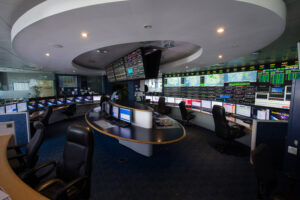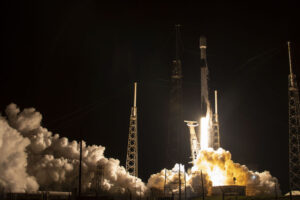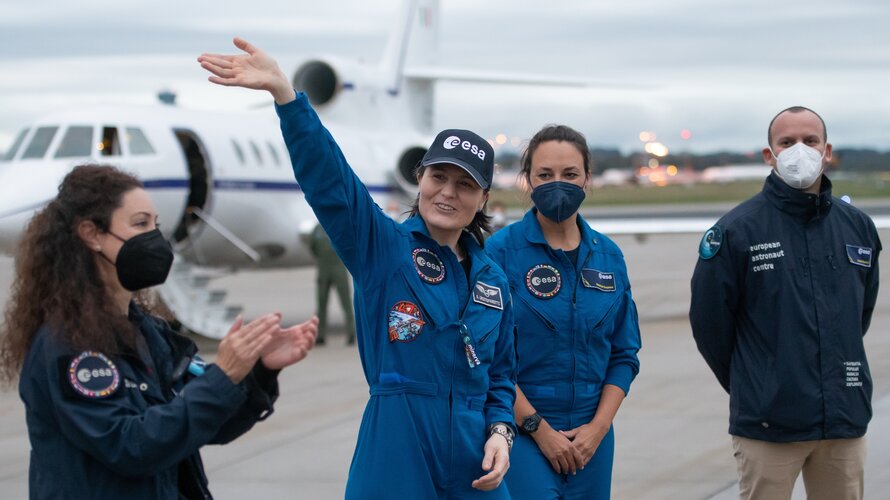Inmarsat sale clears Australia’s foreign investment watchdog
Tuesday, 18 October 2022 19:59
Viasat said Oct. 18 it got the nod from Australia’s foreign investment regulator to take over Inmarsat, although the deal remains subject to regulatory approvals elsewhere.
The post Inmarsat sale clears Australia’s foreign investment watchdog appeared first on SpaceNews.
Pentagon: It’s up to SpaceX to decide what to do about Starlink in Ukraine
Tuesday, 18 October 2022 19:36
Pentagon press secretary Pat Ryder said Oct. 18 DoD would not comment on Elon Musk's recent tweets about Starlink services in Ukraine
The post Pentagon: It’s up to SpaceX to decide what to do about Starlink in Ukraine appeared first on SpaceNews.
Eutelsat fortifying jamming defenses over Middle East
Tuesday, 18 October 2022 19:23
Eutelsat is preparing to deploy the first of two new jamming-resistant broadcast satellites over the Middle East following signal interference in Iran.
The post Eutelsat fortifying jamming defenses over Middle East appeared first on SpaceNews.
How scientists predict solar wind speed accurately using multimodality information
Tuesday, 18 October 2022 17:20
As more and more high-tech systems are exposed to the space environment, space weather prediction can provide better protection for these devices. In the solar system, space weather is mainly influenced by solar wind conditions. The solar wind is a stream of supersonic plasma-charged particles which will cause geomagnetic storms, affect short-wave communications, and threaten the safety of electricity and oil infrastructure when passing over the Earth.
Accurate prediction of the solar wind speed will allow people to make adequate preparations to avoid wasting resources. Most existing methods only use single-modality data as input and do not consider the information complementarity between different modalities.
Uncontrolled rocket reentries are a bigger problem than you think
Tuesday, 18 October 2022 15:47
More than 60% of the launches in 2020 resulted in one or more rocket parts making an uncontrolled reentry into the atmosphere. While thankfully no one was hurt by that debris, with the expected rise in rocket launches over the coming decade the chances of a casualty are increasing. A new study paints the picture of how current methods of assessing risk are inadequate and new steps need to be taken.
Rocketry is a complex business. A typical lunch will usually require multiple stages to get the payload into orbit. Most of the time everything goes well, with the individual stages designed to either burn up in the atmosphere or end up on an escape trajectory away from the Earth. But in 2020 alone, 60% of the launches to low Earth orbit ended up with at least one significantly sized rocket part simply abandoned in an uncontrolled orbit.
New research facility houses largest plasma wind tunnel in the US
Tuesday, 18 October 2022 15:11
In hypersonic flight, an aircraft or spacecraft moves at least five times faster than the speed of sound—producing extreme heat that can push the craft beyond its physical limits. The difficulty and importance of protecting vehicles against those conditions were tragically illustrated in 2003 when slight damage to heat-shielding tiles caused the Space Shuttle Columbia to disintegrate while re-entering Earth's atmosphere.
A unique experimental facility at the University of Illinois Urbana-Champaign will help ensure that such a tragedy is never repeated—and enable unprecedented new adventures in space exploration.
The Plasmatron X is the largest inductively coupled plasma wind tunnel in the United States.
Panasonic Avionics to bring OneWeb LEO broadband to planes
Tuesday, 18 October 2022 13:40
Panasonic Avionics, one of the largest providers of satellite-enabled broadband to aircraft, said Oct. 18 it has reached a deal to sell low Earth orbit (LEO) connectivity services from OneWeb in the second half of 2023.
Partnerships seen as key for LEO operators to enter Asia
Tuesday, 18 October 2022 13:34
While Starlink is ramping up efforts to expand its foothold in Asia, satellite operators there remain undeterred as they expect the U.S. broadband service would end up seeking their help for business.
The post Partnerships seen as key for LEO operators to enter Asia appeared first on SpaceNews.
Samantha Cristoforetti’s first news conference after returning to Earth
Tuesday, 18 October 2022 10:30 Video:
00:53:23
Video:
00:53:23
Watch the replay of Samantha’s first news conference in Europe after almost six months of living and working on board the International Space Station. Samantha talks from ESA’s European Astronaut Centre in Cologne, Germany. Her Minerva mission came to an end last week and she and her colleagues from Crew-4 splashed down off the coast of Florida on 14 October at 22:55 CEST.
Phase Four unveils game changing engine for LEO constellations
Tuesday, 18 October 2022 09:52 Phase Four, the creator of the radio-frequency thruster for satellite propulsion, reports that it will expand its Maxwell turn-key plasma propulsion line and offer satellite manufacturers an industry-first high performance engine using an inexpensive, domestically sourced iodine-based propellant. Max-V leverages the Maxwell Block 2 engine's innovative architecture and builds on the radio-frequen
Phase Four, the creator of the radio-frequency thruster for satellite propulsion, reports that it will expand its Maxwell turn-key plasma propulsion line and offer satellite manufacturers an industry-first high performance engine using an inexpensive, domestically sourced iodine-based propellant. Max-V leverages the Maxwell Block 2 engine's innovative architecture and builds on the radio-frequen DLR's new optical ground station inaugurated
Tuesday, 18 October 2022 09:52 Satellites are increasingly becoming network nodes of the internet. Terrestrial nodes are integrated via fibre optic networks, and satellites can only keep up with current developments on the ground if they are also optically networked. European Commission programmes such as the 'Secure Connectivity Initiative' depend on this technology, as do many commercial networks such as Starlink or Oneweb,
Satellites are increasingly becoming network nodes of the internet. Terrestrial nodes are integrated via fibre optic networks, and satellites can only keep up with current developments on the ground if they are also optically networked. European Commission programmes such as the 'Secure Connectivity Initiative' depend on this technology, as do many commercial networks such as Starlink or Oneweb, Eutelsat strategy update on the proposed combination with OneWeb
Tuesday, 18 October 2022 09:52 Eutelsat Communications (Euronext Paris: ETL) has hosted a Strategic Update on the proposed combination with OneWeb, announced in July 2022.
Eutelsat and key OneWeb shareholders signed a Memorandum of Understanding in July 2022, with a view to combining Eutelsat and OneWeb in an all-share transaction, whereby Eutelsat and OneWeb shareholders will each hold 50% of the Eutelsat shares2. The
Eutelsat Communications (Euronext Paris: ETL) has hosted a Strategic Update on the proposed combination with OneWeb, announced in July 2022.
Eutelsat and key OneWeb shareholders signed a Memorandum of Understanding in July 2022, with a view to combining Eutelsat and OneWeb in an all-share transaction, whereby Eutelsat and OneWeb shareholders will each hold 50% of the Eutelsat shares2. The NASA awards contracts to assess near-space communications capabilities
Tuesday, 18 October 2022 09:52 NASA has selected two companies - Kongsberg Satellite Services (KSAT) USA of Denver and SpaceLink Corporation of McLean, Virginia - to develop capability studies to explore and demonstrate communications and navigation services in support of Artemis missions to the Moon.
The awards, under the Next Space Technologies for Exploration Partnerships-2 (NextSTEP-2) Broad Agency Announcement (BAA
NASA has selected two companies - Kongsberg Satellite Services (KSAT) USA of Denver and SpaceLink Corporation of McLean, Virginia - to develop capability studies to explore and demonstrate communications and navigation services in support of Artemis missions to the Moon.
The awards, under the Next Space Technologies for Exploration Partnerships-2 (NextSTEP-2) Broad Agency Announcement (BAA New Iridium Certus Service Providers to Support U.S. Government Customers
Tuesday, 18 October 2022 09:52 Iridium Communications Inc. (Nasdaq: IRDM) has announced that Iridium partners MetOcean Telematics, NAL Research, and Trace Systems are now Iridium Certus service providers for U.S. government customers, joining Satcom Direct, in this capacity.
These unique, long-term deals will allow these companies to provide Iridium's secure global satellite broadband and midband connectivity for mobile
Iridium Communications Inc. (Nasdaq: IRDM) has announced that Iridium partners MetOcean Telematics, NAL Research, and Trace Systems are now Iridium Certus service providers for U.S. government customers, joining Satcom Direct, in this capacity.
These unique, long-term deals will allow these companies to provide Iridium's secure global satellite broadband and midband connectivity for mobile Orbex secures 40M pounds in Series C Funding round
Tuesday, 18 October 2022 09:52 UK-based spaceflight company Orbex has secured 40.4 million pounds for its Series C funding round, led by a new investor, the Scottish National Investment Bank. The new round of funding will allow the company to scale up its resources as it counts down to the first vertical launch from UK soil, as well as unlocking additional funding to support future projects.
Orbex recently revealed its
UK-based spaceflight company Orbex has secured 40.4 million pounds for its Series C funding round, led by a new investor, the Scottish National Investment Bank. The new round of funding will allow the company to scale up its resources as it counts down to the first vertical launch from UK soil, as well as unlocking additional funding to support future projects.
Orbex recently revealed its 
